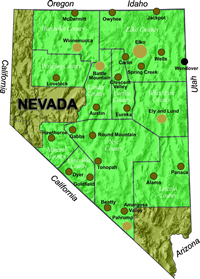ABOUT ɫ��ɫ

Welcome to ɫ��ɫ!
ɫ��ɫ values you! Valuing what we have in common and our differences means we will foster a college climate of mutual trust, tolerance, informed discourse and always seek to promote ɫ��ɫ as a "safe space" to explore new ideas and perspectives with opportunities for you to grow, learn and be successful in a friendly, supportive campus environment. ɫ��ɫ enriches people's lives by providing student-centered, post-secondary education to rural Nevada. ɫ��ɫ students enjoy outstanding academic programs, smaller class sizes, and excellent faculty who really care about our students. We are ɫ��ɫ!
ADMISSIONS

ACADEMICS

For High School Students
STUDENT SERVICES

ɫ��ɫ is "The Gold Standard in the Silver State" when it comes to long-distance education and online education delivery. ɫ��ɫ offers hundreds of classes and a diverse array of certificate and degree programs fully online and fully affordable!
COMMUNITY

ɫ��ɫ wants to be your choice for higher education. ɫ��ɫ offers associate and baccalaureate level instruction in career and technical education and academic areas. About 4,000 students are enrolled annually online from across the country and on campuses and centers across 86,500 square miles, two time zones, and ten of Nevada's largest counties. We border Arizona, Oregon, Idaho, Utah, and California. We are ɫ��ɫ!
INFORMATION

Need to find COVID-19 information quick? Check out our Coronavirus (COVID-19) Information and Resources page!

RESOURCES
FOR MORE INFORMATION
Jake Hinton-Rivera
Vice President for Student Affairs, Title IX Coordinator
ɫ��ɫ, Elko Campus
775.327.2116
jake.hinton-rivera@
gbcnv.edu

Sexual Harassment
ɫ��ɫ will not tolerate sexual harassment of students, faculty, staff and other members of the campus community. Victims of sexual harassment can feel hurt, frustrated, and helpless. As a member institution of the Nevada System of Higher Education (NSHE), ɫ��ɫ adheres to the policies and disciplinary sanctions set forth by the Board of Regents. The President has designated the Administrative Officer/Title IX Coordinator or the Affirmative Action Officer as the officials responsible for receiving complaints of sexual harassment. Any administrator, employee, or supervisor who is aware of an alleged incident of sexual harassment will take immediate action to bring the matter to the attention of the Vice President for Academic and Student Affairs, Title IX Coordinator/Administrative Officer or the Vice President for Business Affairs (Affirmative Action Officer). Both are located in Berg Hall.
Sexual Harassment is Illegal Under Federal and State Law
Sexual harassment including sexual violence is a form of discrimination; it is illegal. No employee or student, either in the workplace or in the academic environment, should be subject to unwelcome verbal or physical conduct that is sexual in nature. Sexual harassment does not refer to occasional compliments of a socially acceptable nature. It refers to behavior of a sexual nature that is not welcome, that is personally offensive, and that interferes with performance.
It is expected that students, faculty and staff will treat one another with respect. For emergency reporting, please contact the staff listed on the Campus Safety Emergency Reporting page.
Sexual Harassment Defined
Under this policy, unwelcome sexual advances, requests for sexual favors, and other visual, verbal or physical conduct of a sexual or gender bias nature constitute sexual harassment when:
Educational Environment
- Submission to such conduct is made either explicitly or implicitly a term or condition of an individual’s academic status (“quid pro quo”);
- Conduct that is sufficiently severe, persistent or pervasive so as to interfere with or limit a student’s ability to participate in or benefit from the services, activities or opportunities offered by the institution (“hostile environment”).
Workplace Environment
- Submission to or rejection of the conduct is used as a basis for academic or employment decisions or evaluations, or permission to participate in an activity (“quid pro quo”); or
- Conduct that is sufficiently severe, persistent or pervasive so as to create a work environment that a reasonable person would consider intimidating, hostile or abusive, and which may or may not interfere with the employee’s job performance(“hostile environment”).
Sexual violence is a severe form of sexual harassment, and refers to physical sexual acts or attempted sexual acts perpetrated against a person’s will or where a person is incapable of giving consent, including but not limited to rape, sexual assault, sexual battery, sexual coercion or similar acts in violation of state or federal law.
Sexual Violence is a Form of Sexual Harassment
Sexual Assault
Sexual Assault means a person subjects another person to sexual penetration, or who forces another person to make a sexual penetration on himself or herself or
another, or on a beast, against the will of the victim or under conditions in which the
perpetrator knows or should know that the victim is mentally or physically incapable
of resisting or understanding the nature of his or her conduct.
For prevention tips and steps of what to do if you have been assaulted, please refer to the Campus Safety Sexual Assault Policy page.
Dating Violence
Dating Violence is an act committed by a person who is or has been in a “dating relationship” with the victim:
- The existence of such a relationship shalf be determined based on the reporting party’s statement and with consideration of the length of the relationship, the type of relationship, and the frequency of interaction between the persons involved in the relationship. “Dating relationship” which means frequent, intimate associations primarily characterized by the expectation of affection or sexual involvement. The term does not include a causal relationship or an ordinary association between persons in a business or social context.
- For the purpose of this definition Dating Violence includes but is not limited to:
- Displaying sexually suggestive objects, pictures, magazines, cartoons, or screen savers;
- Inquiries, remarks, or discussions about an individual’s sexual experiences or activities and other written or oral references to sexual conduct but is not limited to, sexual or physical abuse or the threat of such abuse.
Domestic Violence
Domestic Violence is an act that includes but is not limited to violence which occurs when a person commits one of the following acts against or upon the person’s spouse or former spouse, any other person to whom the person is related
by blood or marriage, any other person with whom the person is or was actually
residing, any other person with whom the person has had or is having a dating
relationship, any other person with whom the person has a child in common, the minor child of any of those persons, the person’s minor child or any other person who has been appointed the custodian or legal guardian for the person’s minor child:
- A battery.
- An assault.
- Compelling the other person by force or threat of force to perform an act from which the other person has the right to refrain or to refrain from an act which the other person has the right to perform.
- A sexual assault.
- A knowing, purposeful or reckless course of conduct intended to harass the other person. Such conduct may include, but is not limited to:
- Stalking.
- Arson.
- Trespassing.
- Larceny.
- Destruction of private property.
- Carrying a concealed weapon without a permit.
- Injuring or killing an animal.
- A false imprisonment.
- Unlawful entry of the other person’s residence, or forcible entry against the other person’s will if there is a reasonably foreseeable risk of harm to the other person from the entry.
Stalking
Stalking is defined to be when a person who, without lawful authority, willfully or maliciously engages in a course of conduct that would cause a reasonable
person to feel terrorized, frightened, intimidated, harassed or fearful for the
immediate safety of a family or household member, and that actually causes the
victim to feel terrorized, frightened, intimidated, harassed or fearful for the
immediate safety of a family or household member, commits the crime of stalking.
Stalking includes but is not limited to:
- Engaging in a course of conduct directed at a specific person that would cause a reasonable person to:
- Fear for the person’s safety or the safety of others; or
- Suffer substantial emotional distress.
- For the purpose of this definition:
- Course of conduct means two or more acts, including, but not limited to, acts in which the stalker directly, indirectly, or through third parties, by any action, method, device, or means follows, monitors, observes, surveils, threatens or communicates to or about, a person, or interferes with a person’s property.
- Substantial emotional distress means significant mental suffering or anguish that may, but does not necessarily, require medical or other professional treatment or counseling.
- Reasonable person means a reasonable person under similar circumstances and with similar identities to the victim.
Coercion
Coercion is:
- the use of violence or threats of violence against a person or the person’s family or property;
- depriving or hindering a person in the use of any tool, implement or clothing; or
- attempting to intimidate a person by threats or force,
- when committed with the intent to compel a person to do or abstain from doing an act that the person has the right to do or abstain from doing.
In the context of sexual misconduct, coercion is the use of pressure to compel another individual to initiate or continue sexual activity against an individual’s will. Coercion can include a wide range of behaviors, including intimidation, manipulation, threats, and blackmail. A person’s words or conduct are sufficient to constitute coercion if they wrongfully impair another individual’s freedom of will and ability to choose whether or not to engage in sexual activity. Examples of coercion include threatening to “out” someone based on sexual orientation, gender identity, or gender expression and threatening to harm oneself if the other party does not engage in the sexual activity.
Consent
Consent is defined as:
- An affirmative, clear, unambiguous, knowing, informed, and voluntary agreement between all participants to engage in sexual activity. Consent is active, not passive. Silence or lack of resistance cannot be interpreted as consent. Seeking and having consent accepted is the responsibility of the person(s) initiating each specific sexual act regardless of whether the person initiating the act is under the influence of drugs and/or alcohol.
- The existence of a dating relationship or past sexual relations between the participants does not constitute consent to any other sexual act.
- The definition of consent does not vary based upon a participant’s sex, sexual orientation, gender identity or gender expression.
- Affirmative consent must be ongoing throughout the sexual activity and may be withdrawn at any time. When consent is withdrawn or cannot be given, sexual activity must stop.
- Consent cannot be given when a person is incapacitated. Incapacitation occurs when an individual lacks the ability to fully, knowingly choose to participate in sexual activity. Incapacitation includes impairment due to drugs or alcohol (whether such use is voluntary or involuntary); inability to communicate due to a mental or physical condition; the lack of consciousness or being asleep; being involuntarily restrained; if any of the parties are under the age of 16; or if an individual otherwise cannot consent.
- Consent cannot be given when it is the result of any coercion, intimidation, force, or threat of harm.
Read more about remedies, interim measures, and complaint procedures online. (Remedies, interim measures and complaint procedures can be found in the current ɫ��ɫ Course Catalog)
For More Information Contact
Jake Hinton-Rivera
Vice President for Student Affairs, Title IX Coordinator
ɫ��ɫ, Elko Campus
775.327.2116
jake.hinton-rivera@gbcnv.edu
Why ɫ��ɫ
ɫ��ɫ wants to be your choice for higher education. ɫ��ɫ offers associate and baccalaureate level instruction in career and technical education and academic areas. About 4,000 students are enrolled annually online from across the country and on campuses and centers across 86,500 square miles, two time zones, and ten of Nevada's largest counties. We border Arizona, Oregon, Idaho, Utah, and California. We are ɫ��ɫ!


